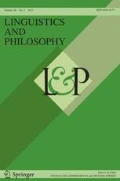Abstract
The semantic automata framework, developed originally in the 1980s, provides computational interpretations of generalized quantifiers. While recent experimental results have associated structural features of these automata with neuroanatomical demands in processing sentences with quantifiers, the theoretical framework has remained largely unexplored. In this paper, after presenting some classic results on semantic automata in a modern style, we present the first application of semantic automata to polyadic quantification, exhibiting automata for iterated quantifiers. We also discuss the role of semantic automata in linguistic theory and offer new empirical predictions for sentence processing with embedded quantifiers.
Similar content being viewed by others
References
Aho, A. V., Lam, M. S., Sethi, R., & Ullman, J. D. (2006). Compilers: Principles, techniques, and tools (2nd ed.). Upper Saddle River, NJ: Prentice Hall.
Barwise J., Cooper R. (1981) Generalized quantifiers and natural language. Linguistics and Philosophy 4(2): 159–219
Chater, N., & Oaksford, M. (1999). The probability heuristics model of syllogistic reasoning. Cognitive Psychology, 38(2), 191–258. ISSN 0010-0285. doi:10.1006/cogp.1998.0696. http://www.ncbi.nlm.nih.gov/pubmed/10090803.
Chomsky, N. (1959). On certain formal properties of grammars. Information and Control, 2(2), 137–167. ISSN 00199958. doi:10.1016/S0019-9958(59)90362-6.
Clark, R. (2011). On the learnability of quantifiers. In J. van Benthem & A. ter Meulen (Eds.), Handbook of logic and language (2nd ed., pp. 911–923). Amsterdam: Elsevier B.V. ISBN 9780444537263. doi:10.1016/B978-0-444-53726-3.00020-7.
Dehaene S. (1997) The number sense: How the mind creates mathematics. Oxford University Press, Oxford
Gierasimczuk, N. (2009). Identification through inductive verification application to monotone quantifiers. In P. Bosch, D. Gabelaia, & J. Lang (Eds.), 7th International Tbilsi symposium on logic, language, and computation, TbiLLC 2007, volume 5422 of Lecture notes in artificial intelligence (pp. 193–205).
Gold, E. M. (1967). Language identification in the limit. Information and Control, 10(5), 447–474. ISSN 00199958. doi:10.1016/S0019-9958(67)91165-5.
Hopcroft, J. E., Motwani, R., & Ullman, J. D. (2001) Introduction to automata theory, languages, and computation (2nd ed.). Boston: Addison Wesley.
Keenan E. L. (1992) Beyond the Frege boundary. Linguistics and Philosophy 15(2): 199–221
Keenan, E. L. (1996). The semantics of determiners. In S. Lappin (Ed.), The handbook of contermporary semantic theory (Number 1989, Chap. 2, pp. 41–63). Oxford: Blackwell.
Keenan, E. L., & Westerståhl, D. (2011). Generalized quantifiers in linguistics and logic. In J. van Benthem & A. ter Meulen (Eds.), Handbook of logic and language (2nd ed., pp. 859–910). Amsterdam: Elsevier.
Lewis D. (1970) General semantics. Synthese 22: 18–67
Lidz, J., Pietroski, P., Halberda, J., & Hunter, T. (2011). Interface transparency and the psychosemantics of most. Natural Language Semantics, 19(3), 227–256. ISSN 0925-854X. doi:10.1007/s11050-010-9062-6.
Lindström, P. (1966). First order predicate logic with generalized quantifiers. Theoria, 32, 186–195. ISSN 00224812. http://onlinelibrary.wiley.com/doi/10.1111/j.1755-2567.1966.tb00600.x/abstract.
Marr D. (1982) Vision. Freeman, San Francisco
McMillan, C. T., Clark, R., Moore, P., Devita, C., & Grossman, M. (2005). Neural basis for generalized quantifier comprehension. Neuropsychologia, 43(12), 1729–1737. ISSN 0028-3932. doi:10.1016/j.neuropsychologia.2005.02.012. http://www.ncbi.nlm.nih.gov/pubmed/16154448.
McMillan, C. T., Clark, R., Moore, P., & Grossman, M. (2006). Quantifier comprehension in corticobasal degeneration. Brain and Cognition, 62(3), 250–260. ISSN 0278-2626. doi:10.1016/j.bandc.2006.06.005. http://www.ncbi.nlm.nih.gov/pubmed/16949714.
McNaughton, R., & Papert, S. A. (1971) Counter-free automata, volume 65 of MIT research monographs. Cambridge, MA: The MIT Press.
Mostowski A. (1957) On a generalization of quantifiers. Fundamenta Mathematicae 44: 12–36
Mostowski M. (1991) Divisibility quantifiers. Bulletin of the Section of Logic 20(2): 67–70
Mostowski M. (1998) Computational semantics for monadic quantifiers. Journal of Applied Non-Classical Logics 8: 107–121
Peacocke C. (1986) Explanation in computational psychology: Language, perception and level 1.5. Mind and Language 1(2): 101–123
Peters S., Westerståhl D. (2006) Quantifiers in language and logic. Clarendon Press, Oxford
Pietroski P., Lidz J., Hunter T., Halberda J. (2009) The meaning of ‘most’: Semantics, numerosity and psychology. Mind and Language 24(5): 554–585
Smolensky P. (1988) On the proper treament of connectionism. Behavioral and Brain Sciences 11: 1–23
Soames S. (1984) Linguistics and psychology. Linguistics and Philosophy 7(2): 155–179
Suppes, P. (1980). Procedural semantics. In R. Haller & W. Grassl (Eds.), Language, logic, and philosophy: Proceedings of the 4th international Wittgenstein symposium (pp. 27–35). Vienna: Hölder-Pichler-Tempsy.
Szabolcsi, A. (2009). Quantification. Research surveys in linguistics. Cambridge: Cambridge University Press.
Szymanik, J. (2007). A comment on a neuroimaging study of natural language quantifier comprehension. Neuropsychologia, 45(9), 2158–2160. ISSN 0028-3932. doi:10.1016/j.neuropsychologia.2007.01.016. http://www.ncbi.nlm.nih.gov/pubmed/17336347.
Szymanik, J. (2010). Computational complexity of polyadic lifts of generalized quantifiers in natural language. Linguistics and Philosophy, 33(3), 215–250. ISSN 0165-0157. doi:10.1007/s10988-010-9076-z.
Szymanik, J., & Zajenkowski, M. (2010a). Comprehension of simple quantifiers: Empirical evaluation of a computational model. Cognitive Science, 34(3), 521–532. ISSN 1551-6709. doi:10.1111/j.1551-6709.2009.01078.x. http://www.ncbi.nlm.nih.gov/pubmed/21564222.
Szymanik, J., & Zajenkowski, M. (2010b) Quantifiers and working memory. Lecture Notes in Artificial Intelligence, 6042, 456–464.
Szymanik, J., & Zajenkowski, M. (2011). Contribution of working memory in parity and cproportional judgments. Belgian Journal of Linguistics, 25(1), 176–194, ISSN 07745141. doi:10.1075/bjl.25.08szy. http://openurl.ingenta.com/content/xref?genre=article&issn=0774-5141&volume=25&issue=1&spage=176.
van Benthem J. (1986) Essays in logical semantics. D. Reidel, Dordrecht
van Benthem, J. (1989). Polyadic quantifiers. Linguistics and Philosophy, 12(4), 437–464. ISSN 0165-0157. doi:10.1007/BF00632472.
Westerståhl, D. (1989). Quantifiers in formal and natural languages. In D. Gabbay & F. Guenthner (Eds.), Handbook of philosophical logic (Vol. 4, pp. 1–132). Dordrecht: D. Reidel.
Author information
Authors and Affiliations
Corresponding author
Rights and permissions
About this article
Cite this article
Steinert-Threlkeld, S., Icard, T.F. Iterating semantic automata. Linguist and Philos 36, 151–173 (2013). https://doi.org/10.1007/s10988-013-9132-6
Published:
Issue Date:
DOI: https://doi.org/10.1007/s10988-013-9132-6




